4. Living colors of Montréal¶
RESEARCHING AND FORAGING¶
This week's assignment is about natural dyes and I thought it would be fun to go for a hike in the woods in order to forage my ingredients. But first, in order to have a bit of inspiration, I foraged the internet and found an interesting book called La teinturerie domestique from the 1930's on domestic dyeing. It talks about different Quebecois indigenous ingredients that can be used to create dyes.

I went to hike near my mother's house, in the Bois de Saraguay , and the first ingredient i found really quickly was sumac. It was right along the edge of the forest. Then i found some acorns hats, some fern and some cedar trims that had been discarded by someone.

Here's where I found these ingredients:

MORDANTING THE TEXTILES¶
After thoroughly washing the fabrics, you need to mordant them, in order for the dye to properly penetrate the fibre. This requires you to weigh your fibers, while they are dry. My textiles weighed at 220g for the wool and 105g for the cotton. I decided to mordant both textiles in the same pot, with 48.75g of Alum and 19.5g of cream of tartar.

All you need to do for this step is to heat up your water, dilute the alum and cream of tartar, dunk your textiles and wait for 2 hours. I was careful not the heat it up too much, since i had some wool in there, I didn't want to damage the textile.
 After 2 hours, rinse the fibers. Avoid changing the temperature of the water too sudenly when you are working with wool.
After 2 hours, rinse the fibers. Avoid changing the temperature of the water too sudenly when you are working with wool.
DYE POTS¶
In order to create the dye, you just need to add water to your dye stuff and heat it up. I left my dye stuff steeping for 2 hours before moving to the next step (which is to test the PH to create color variations).
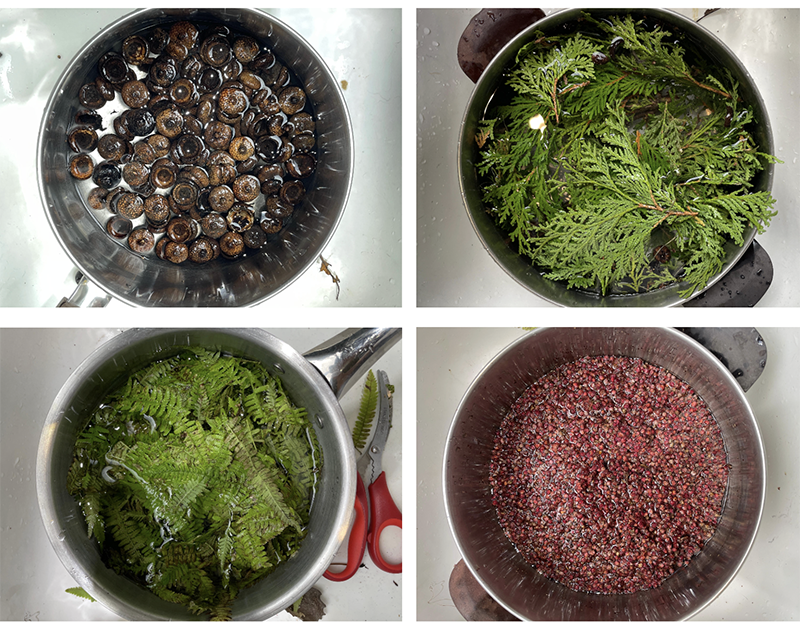
When your dye has steeped for long enough, you can strain it to remove the dye stuff.
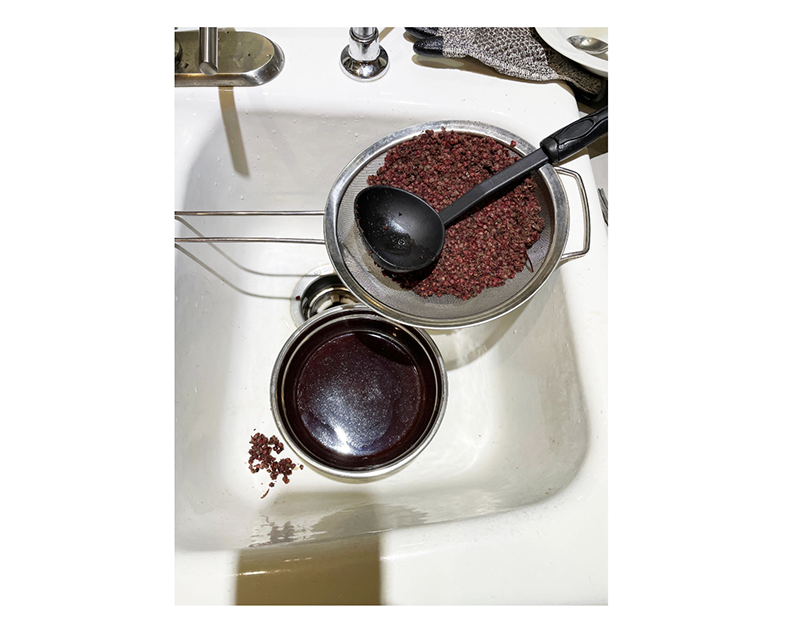
EXPERIMENTING WITH PH¶
At this step, you can extract a little bit of the dye and separate in into different containers. Using PH strips, you can test the acidity/alkalinity of your dye. All 3 dyes were acid in my case, so I used some Sodium Carbonate in order to alter the ph. Doing this ends up changing the color of the dye, which is really fun to watch. I did not measure anything, i just added the sodium in and retested the dye with a PH strip. The sumac seems to have the most interesting color variation, I think i will focus on the sumac moving forward.
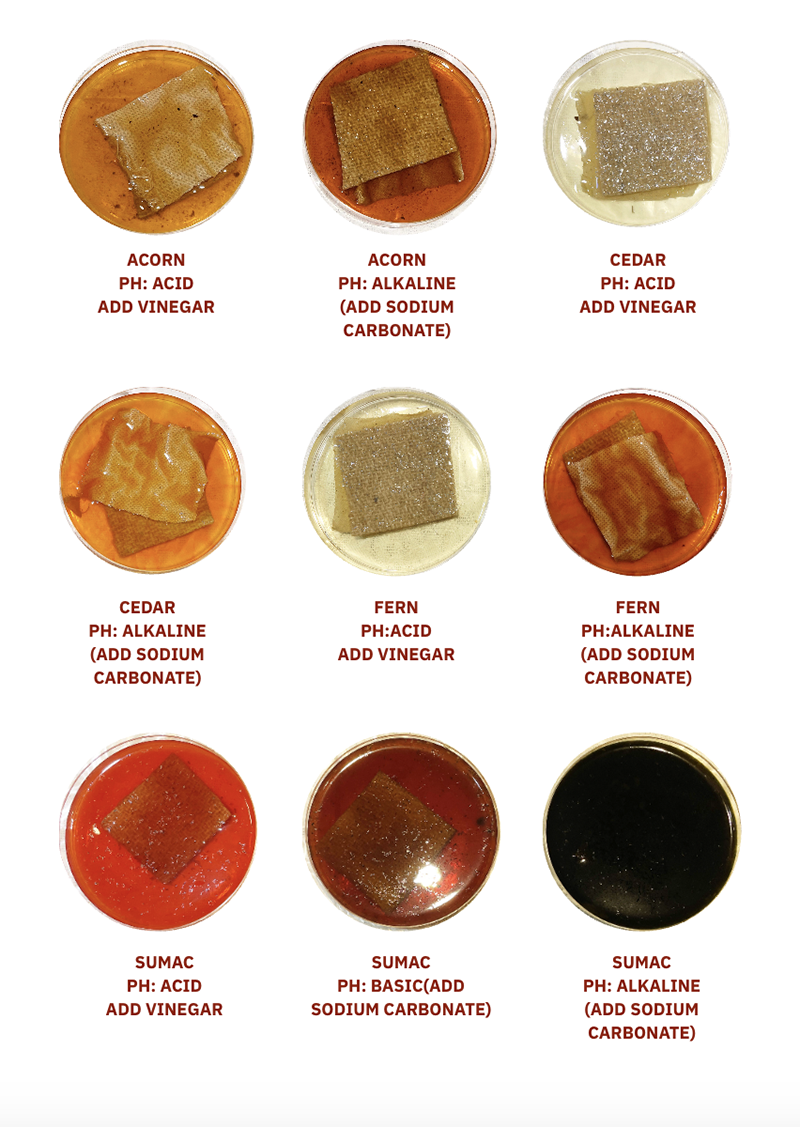
SOAKING IN THE DYE¶
I ended up using the sumac to dye the rest of my textiles. I really liked the pink and green tones you get from this dye.
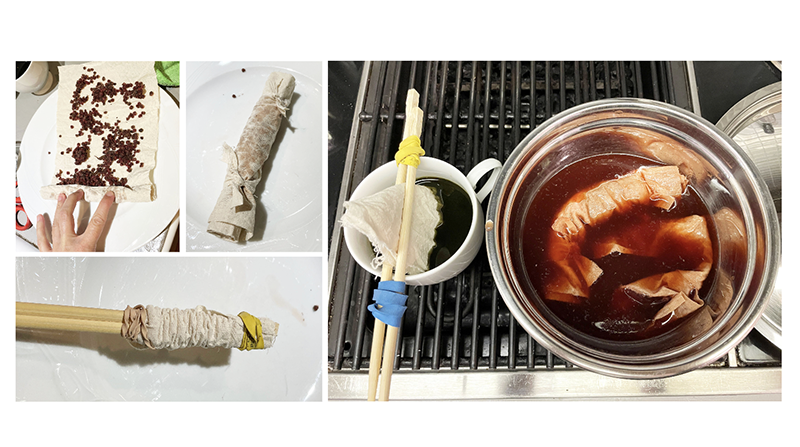
Below is the result (still wet) of the piece of fabric I wrapped with the berries. As you can see, the effect is not significant. Cecilia made me realize that this is because i steeped it instead of steaming it. So, next time i will steam it!
I was then tempted to sprinkle some Sodium Carbonate on the fabric and see what happens. It created a little speckle effect that is interesting.
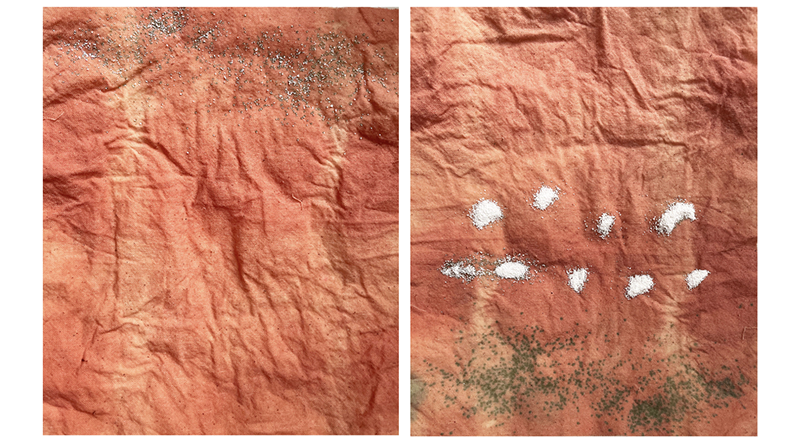 That led me to try using a quick stencil to sprinkle the powder into shapes.
That led me to try using a quick stencil to sprinkle the powder into shapes.

RESULTS¶
Here are the final results. The sumac is by far the most interesting, with the most color variation. It was also the ingredient i found the most of, so my dye was adequately concentrated. I don't think I gathered enough dye stuff for my other three pots.
Below, I've displayed the results organized by ingredient. Within these categories, I've displayed the results by PH variation. As I've mentioned in my PH section, my dyes were all acidic to begin with (as indicated by my ph strips). So, in order to create a basic or alkaline solution, I used Sodium Carbonate in varying concentrations. I did not measure the exact amount of sodium carbonate used. But, basically, i used a smaller concentration in order to create a basic solution and higher concentration to create an alkaline solution.
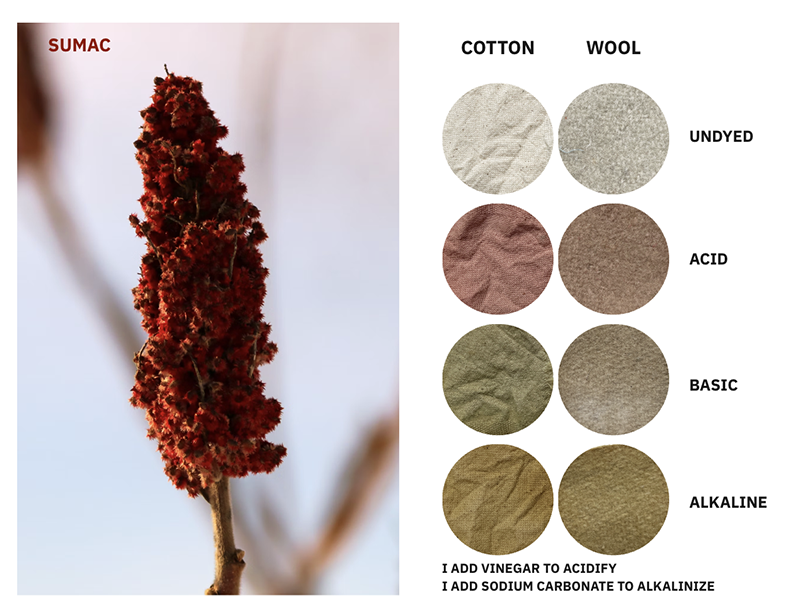
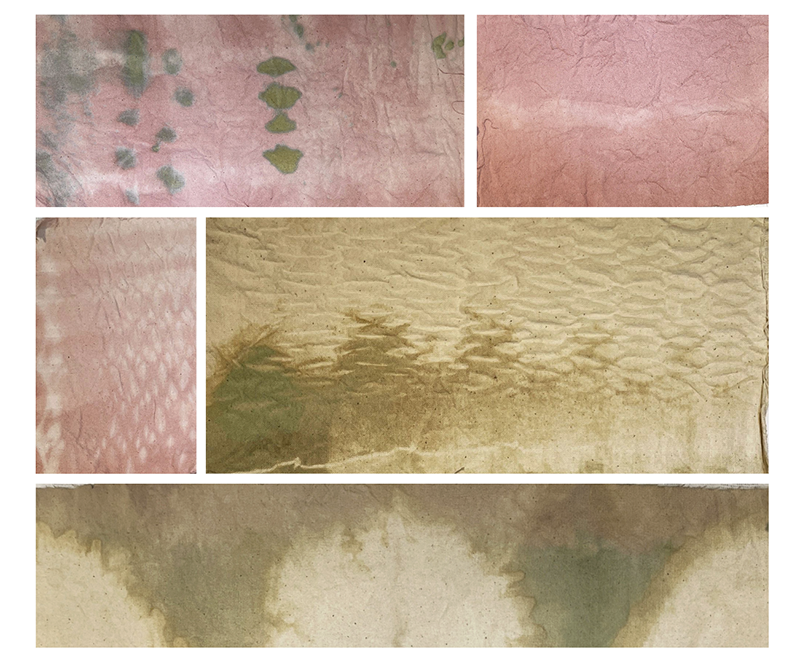
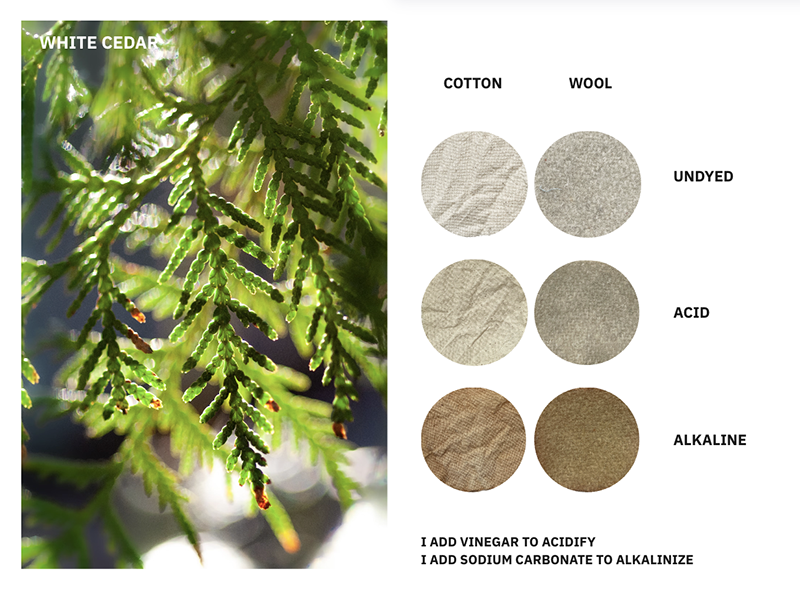

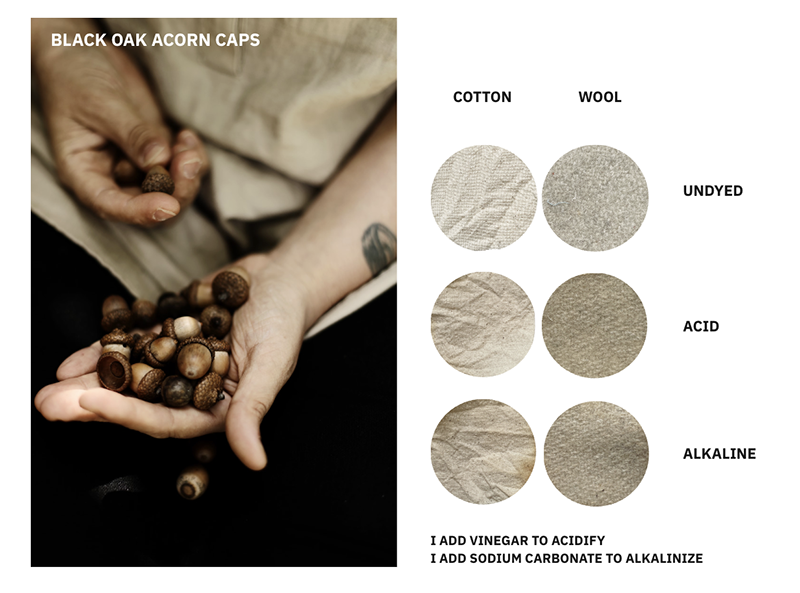
RECYCLING DYE INTO AN INK¶
Making ink out of leftover dye is a super simple process. Here's how I did it: I transferred about 119g of dye into a pan and put it over low heat to simmer for about 1.5 hours. It simmered down to about 11g of concentrated dye. From there I added about 1g of a binder called gum arabic, and that is all.
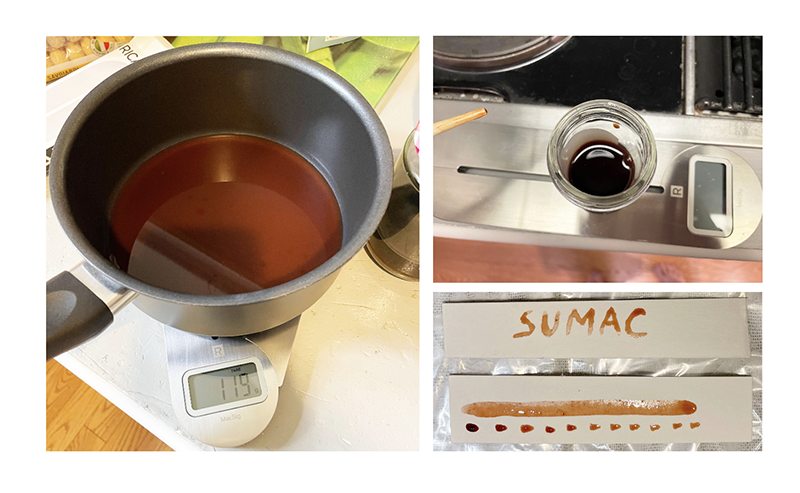
THOUGHTS ON PROCESS¶
What i enjoyed the most about this week was the process of foraging and using local ingredients found nearby. While i was out foraging, i spotted a lot of different ingredients I was curious about and that I wanted to experiment with. Ultimately i decided to use ingredients which i knew (from reading the Teinturerie Domestique book) were commonly used in deying. I did this because i was afraid of using ingredients that wouldn't produce anything, and then i would not have been able to see the entire process and understand the ph variation, etc. But, now that i have had an overview of the process and i've seen some of the possible results, I feel more confident to go back out there and experiment with ingredients i don't know.
I also want to try the acorns again and experiment with using iron as the modifyer. I've seen that it can produce a really beautiful black color. I would love to deep dive into black dyes. I love wearing black, but often I don't like the smell of certain black clothing when you buy them, they have a very strong odor that is unpleasant, I've read that this is caused by formaldehye, which is carcinogenic. I would like to explore the range of esthetics you can create with black dyes, without using nasty chemicals.
Some thoughts on organization: I find that i had a hard time getting organized for this assignment, probably because it felt like a lot of information in the beginning. So I did not document everything as well as I would have wanted, because i was overwhelmed. For example I did not weight my dye stuff, i did not weight my modifyers, etc. But going through the process made me understand the importance of doing this because there are so many variables that can affect the outcome. I am giving myself some grace, since it was my first time doing natural dyeing, but the next time I do this i will be much more diligent about writing down everything i did and saving it into clear charts.